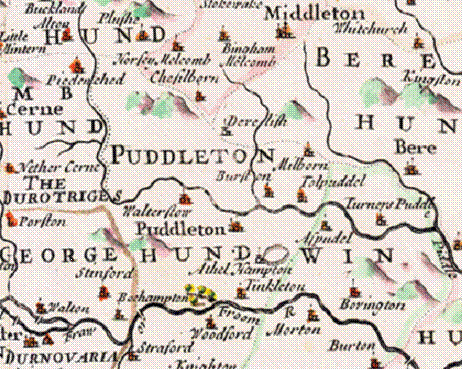
Population Size in a Village: This is a map of a small part of Dorset in the south of England.

Taken from R. Morden, CAMDEN’S BRITTANIA 1695
The information was drawn from the Domesday Book of 1086, which was the most complete inventory and census and country has ever done. Of the thousands of villages recorded in the book, I have read that essentially all of them are still in existence. That is a very enviable record considering the number of great nations today where the birth rate is below replacement levels. Whatever it takes to keep a population going, these people had it.
For years I used this map as an estimate of how big a social pool a substance farming community had. I reasoned thus. The letters “HUND” mean enough land for a hundred farms, each called a “hide” and having enough land to support a family. The information had been gathered for land owners, not travelers so the hunds are recorded but not the roads. There was a scale with the map, in fact three scales each slightly different with no explanation of why, but with any of the scales a hund measures about six miles across.
A modern commuter is loath to spend more than an hour each way with his commute, whether he is hammering through congested traffic or lounging on a private jet at hundred of miles an hour. This sense that an hour is long enough may be a remnant of the decisions that had to be made by subsistence farmers. For the farmer, who may walk at a brisk three miles an hour, the cost is not only time, it is energy. The farmer must burn about 100 kilocalories per mile. To walk from the center of his hund to the edge then costs 300 kilocalories each way or a total of 600.
For sedentary mortals, 2,000 kilocalories a day is quite sufficient, thank you. But for a man working eight hours in the field, he might burn another 100 an hour, or 2,800 a day. You can expect him to spend a considerable amount of time leaning on his hoe, but he can just about manage. Now if you throw another 600 on top of that, he must eat and digest 3,400 calories in the 14 hours when he is not walking or sleeping, and he is going to need to get his 8 hours of sleep, so that is 3,400 calories to digest in the remaining 6 hours. Your GI tract shuts down when you fall asleep so digestion stops.
Now he has the opportunity to work a field that is outside his hund, say a 2 hour walk each way. If he tries to exploit it, he must burn another 600 calories and digest the whole 4,000 calories in the remaining 4 hours. Unless he is very young and energetic, that is not going to happen.
Besides it is very hard to keep an eye on a field that is an hour’s walk away.
That means his work prospects and thus his social horizon extends out no farther than 3 miles, which means he will marry a woman from one of the 99 surrounding families and effective population size is 200.
The villages recorded in the Domesday Book have mostly survived ever since and already doubtless had a long history. The population had achieved a pattern of work and socialization that was stable, and their success encouraged me to think that 200 was the magic number. That is the size of success for a population’s gene pool.
Now I am less sure.
It seems likely that a gene pool that large could survive, but go back and look at the map more closely. There are tiny little hamlets, multiple villages within each hund, maybe 10 or so. So does a man marry a woman in the same village or in a neighboring village.
The population was probably controlled by the fact that a man could not marry until he could support a wife. In other words, he had to have a farm. There were only so many farms available, so there were only so many families. But fertility was high. That meant that there was more than one capable man to take over the management of a farm when it became available. Others might work with him, live with him, help him, but they were not going to be able to marry.
At the same time there were more women than there were men who could support them. Even though childbirth was far more dangerous then than now, a woman might find becoming a wife and a mother a very attractive life compared with the alternative of being a servant all her life. So when the man became able to marry, he would have little trouble finding a wife within his own little hamlet. Of course he could go a few minutes walk to the next habitation village, but that would mean snubbing all the hopeful women in his own. In a tight knit community, that might be a bit of a bad idea. And there would be no lacking of busybodies ready to point that out.
So I suspect that the 200 population of my dreams may have been oversized. It might have been most common to marry very close to home and the gene pool may have been typically a lot smaller.
There have been 136 visitors so far.